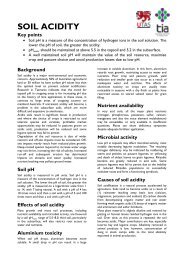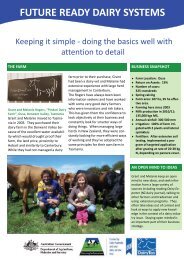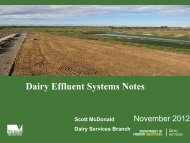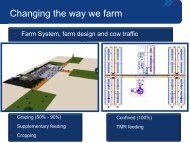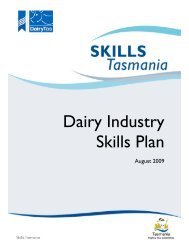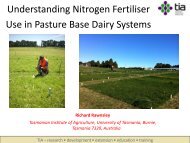Create successful ePaper yourself
Turn your PDF publications into a flip-book with our unique Google optimized e-Paper software.
Sump volumeSump capacity <strong>and</strong> shapes can be designed differently to match different site requirements, pumping arrangements <strong>and</strong>management schemes.Small diameter pipes have been used as sumps for pump installations servicing milking sheds. These sumps are usually450 mm to 900 mm in diameter <strong>and</strong> 1.2 metres deep. This arrangement offers little buffer storage thereby needing a pumpwith a similar capacity to the peak inflow rates. In the event of pump failure an overflow will occur. Access for cleaning canalso be restricted due to the small diameters. Larger sumps will overcome the issues identified above <strong>and</strong> will also providegreater flexibility in the management of the pumping system.Larger sumps are advocated to provide storage for 4 to 6 milking's, or at least storage for 1 milking. This allows time forpump repairs in case of breakdowns <strong>and</strong> allows for easier access for cleaning.A larger sump also allows greater flexibility in pump selection thereby optimising performance <strong>and</strong> minimising operatingcosts. <strong>Pumps</strong> turning on <strong>and</strong> off constantly will also increase the chance of a burn out. Therefore bigger sumps allow timebetween pumping to be maximised. The sump depth should be matched to the column length of the pump to ensure idealflow conditions.<strong>Pumps</strong>Pump selectionWhen pumps are used to transport dairy effluent, problems can arise if unsuitable equipment is used. Factors to consider inthe selection of an effluent h<strong>and</strong>ling pump include:• pressure or head requirements• flow rate• effluent volume• the solids content of the effluent stream• power source• suction <strong>and</strong> priming characteristics• quality of components• maintenance• reliability <strong>and</strong> price.Pump operating pressures vary considerably with application. Moving effluent to a nearby pond system of similar elevationrequires a low lift pump with a system head of between 3 to 10 metres. Sprinkler systems for l<strong>and</strong> application require muchhigher working heads at between 20 <strong>and</strong> 50 metres.Care must be taken in following flow rate guidelines provided by pump manufactures. These flow rates are for pumpingclean water not effluent. Pumping effluent can reduce pumping efficiency dramatically. When a sump is used at the dairyyard without a solids trap the pump must be able to h<strong>and</strong>le solids. The effluent from dairies can also be corrosive, so pumpsshould be constructed from brass, cast iron or gun metal in preference to mild steel.Type of pumpsThe types of pumps generally used on dairy effluent systems are described below <strong>and</strong> their characteristics are listed inTable 1. These pumps are basically used to either pump out sumps or to transport effluent from ponds to re-use systems orchannels for sh<strong>and</strong>ying with fresh water. The configuration of the pump may vary depending on which of these applicationsit is used for.




